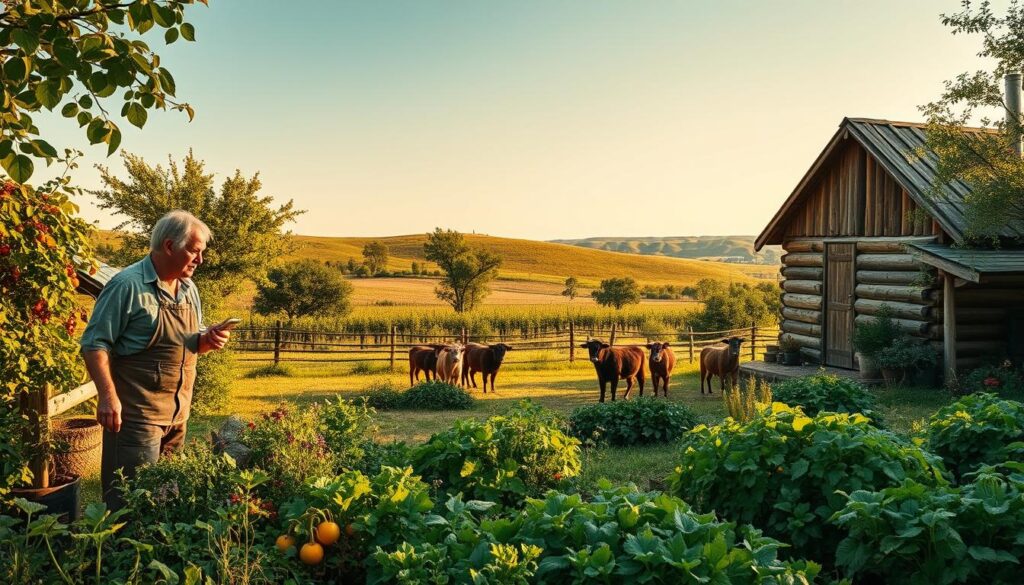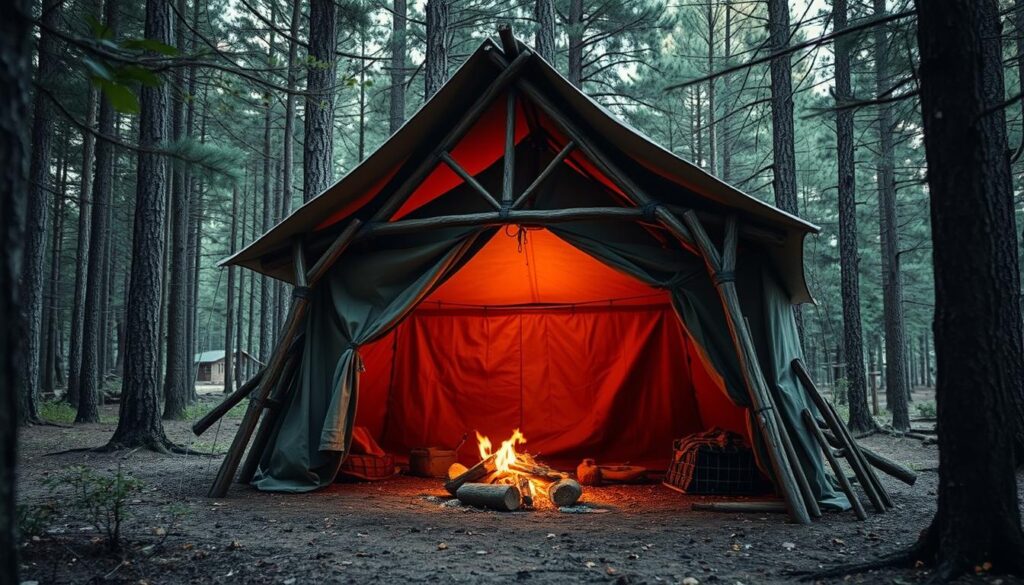Starting a self-sufficient lifestyle has changed me a lot. It’s not just about living green; it’s about feeling truly fulfilled and free.
My journey to a sustainable homestead was full of learning and hard work. I’ll share my story and tips to help you start your own path to self-sufficiency.
Key Takeaways
- Understand the benefits of a self-sufficient lifestyle
- Learn how to plan and start your sustainable homestead
- Discover practical tips for reducing your environmental impact
- Gain insights into creating a fulfilling and independent life
- Explore the importance of community and resources in sustainable living
Understanding Sustainable Homesteading
Sustainable homesteading is more than a lifestyle; it’s a way to live in harmony with nature. As I explore eco-friendly living, I see that a sustainable homestead is based on key elements.
What is a Sustainable Homestead?
A sustainable homestead is a self-sufficient place that doesn’t harm the environment. It uses organic farming, renewable energy, and water conservation. The aim is to have a system where waste is low and resources are used well.
“The best way to predict the future is to create it,” a saying that fits well with sustainable homesteading. It shows the value of living thoughtfully and proactively.
Benefits of Sustainable Living
Living sustainably has many benefits. It reduces harm to the environment, improves health, and boosts food security. It also helps save money on bills and makes life more resilient.
- Reduced carbon footprint
- Increased self-sufficiency
- Improved health through organic food consumption
Key Principles to Follow
To have a successful sustainable homestead, follow these key principles:
- Assess and improve your land’s use
- Use renewable energy
- Practice sustainable farming
- Save water and cut down on waste
By following these principles and choosing eco-friendly living, people can build a sustainable homestead. This not only helps them but also makes the planet healthier.
Planning Your Sustainable Homestead
Planning is key to a sustainable homestead that works with nature. A good plan is vital for a homestead that is self-sufficient and successful.
Assessing Your Land and Resources
The first step is to check your land and resources. Look at the land’s shape, weather, soil, and plants. Knowing these helps plan your homestead’s layout.
Also, find out about natural resources like sunlight, wind, and water. For example, knowing where the sun shines helps place solar panels.
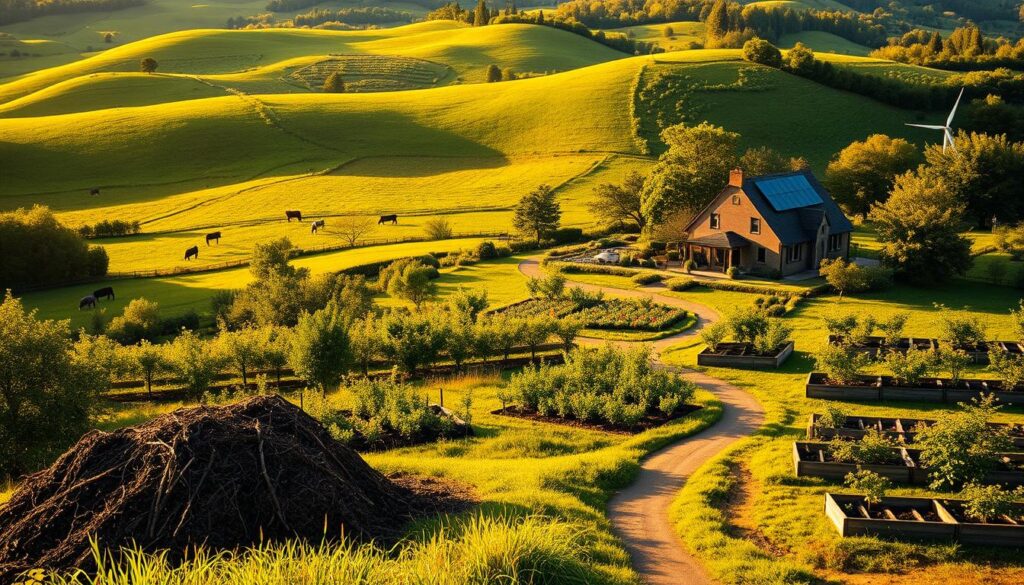
Creating a Sustainable Home Design
After assessing the land, design a home that fits with nature. Use green building practices like local materials and energy saving. This reduces waste.
A good design also lasts long and is easy to maintain. Use natural insulation and collect rainwater to lower your impact on the environment.
“The way we build our homes can either contribute to the problem of climate change or be part of the solution.” –
Setting Clear Goals and Objectives
Setting clear goals is essential for a sustainable homestead. Define what sustainability means to you. Then, set targets for energy use, food, and waste.
Here’s a simple table to show how to set goals:
| Goal | Objective | Timeline |
|---|---|---|
| Reduce energy consumption | Install solar panels and improve insulation | 6 months |
| Increase food production | Develop a permaculture garden and raise livestock | 1 year |
| Minimize waste | Implement recycling and composting programs | 3 months |
By following these steps and focusing on sustainability, you can build a thriving homestead. It supports your lifestyle and helps the planet.
Choosing the Right Location
The location of your homestead is key to its success. It’s important to choose wisely. When I started my sustainable homestead, I knew location was the base for all decisions.
Factors to Consider in Site Selection
Choosing the right site for your homestead is a big deal. Topography, soil quality, and access to natural resources are top factors. For example, land slope affects drainage and erosion, while soil quality impacts crop growth.
Also, having a reliable water source nearby is critical. Proximity to a reliable water source is vital for your homestead’s success. Plus, considering the area’s natural ecosystem and biodiversity helps in creating a sustainable homestead.
| Factor | Importance | Considerations |
|---|---|---|
| Topography | High | Slope, drainage, erosion risk |
| Soil Quality | High | Fertility, composition, erosion risk |
| Water Availability | Critical | Proximity to water source, rainfall, conservation methods |
How Climate Affects Sustainability
Climate is a big factor in your homestead’s sustainability. Knowing your local climate is key. For example, in dry areas, rainwater harvesting is essential.
The climate also affects what crops and livestock you can have. Choosing climate-resilient practices and planning for climate risks are vital for your homestead’s future.
Zoning and Regulations to Know
Before choosing a location, know the local zoning laws and regulations. They dictate what you can do on your land. Following these laws avoids legal trouble later.
- Research local zoning laws and ordinances.
- Understand any restrictions on land use.
- Check for any incentives for sustainable practices.
Water Management Strategies
Creating a sustainable homestead led me to focus on water management. It’s not just about saving water. It’s also about using it wisely and sustainably.
Rainwater harvesting is a key strategy I’ve adopted. It collects and stores rainwater for irrigation, livestock, and household use after treatment. This method reduces groundwater and surface water demand, helping to keep the water table healthy and preventing waterlogging.
Rainwater Harvesting Techniques
There are many ways to harvest rainwater, like rooftop and surface runoff collection. Rooftop collection channels rainwater into storage tanks. Its success depends on the roof’s material, size, and local rainfall.
To keep harvested water clean, it’s vital to maintain storage tanks well. Regular checks and cleanings, along with first flush devices, improve water quality.
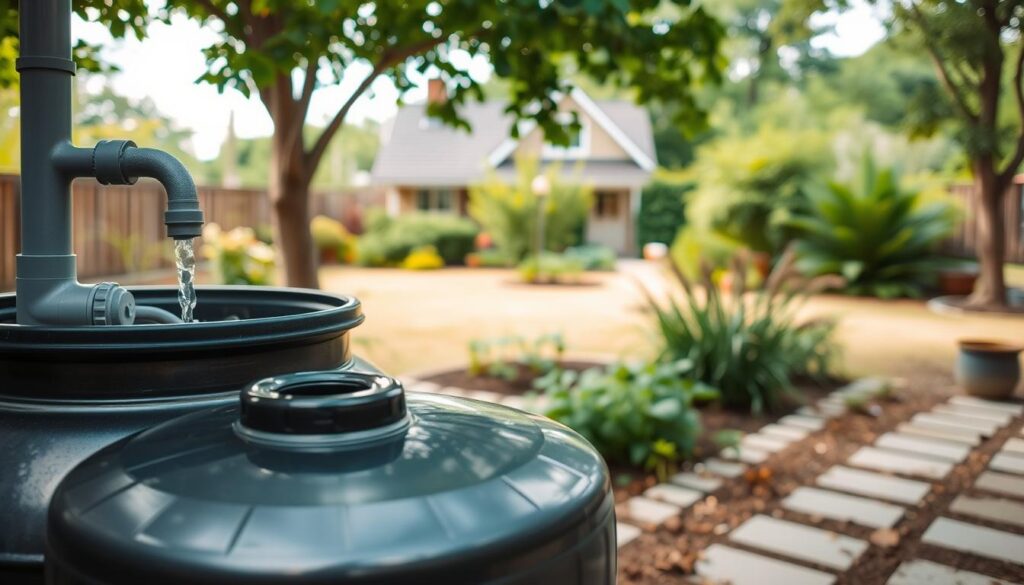
Water Filtration and Purification
Rainwater harvesting is great, but ensuring water safety is also key. Water filtration and purification are essential. Methods include sedimentation, filtration, and disinfection.
Simple filters like sand or charcoal can remove particles and some microorganisms. For deeper purification, UV treatment or boiling can kill bacteria and viruses.
Efficient Irrigation Practices
Efficient irrigation is vital for water conservation and proper plant watering. Drip irrigation and mulching reduce evaporation and runoff, ensuring water reaches plant roots.
Drip irrigation delivers water directly to plants, reducing overwatering and evaporation loss. Mulching retains soil moisture and controls weeds that compete for water.
By using these strategies, homesteaders can greatly reduce their water use while keeping their homestead productive and sustainable.
Energy Efficiency and Renewable Resources
Starting my sustainable homestead showed me how key energy efficiency is. It’s not just about cutting down on carbon emissions. It’s also about being more independent and not needing outside energy as much.
Using renewable energy sources is a big step towards energy efficiency. Solar power is a top choice for many.
Solar Power Installation
Putting in solar panels changed my homestead for the better. It cut down my use of non-renewable energy and my energy bills. When you’re thinking about solar panels, first figure out how much energy you use and how sunny your place is.
| Factors to Consider | Description | Benefits |
|---|---|---|
| Energy Needs Assessment | Evaluate your energy consumption patterns | Determine the appropriate size of the solar panel system |
| Solar Potentia | Assess the amount of sunlight your site receives | Maximize energy production |
| System Cost | Consider the upfront cost of solar panels and installation | Long-term savings on energy bills |
Wind Energy Options
Wind energy is another great renewable option. A wind turbine can be a big power source, if your area gets a lot of wind.
When looking at wind energy, think about the turbine’s size, how much it costs to install, and how windy your area is. Also, check local rules and zoning laws.
Passive Solar Design Tips
Using passive solar design can also boost energy efficiency. This means designing your home to use the sun’s heat and light naturally.
- Orient your home to face the sun
- Use thermal mass to absorb and release heat
- Incorporate large south-facing windows for natural heating
- Utilize shading devices to prevent overheating
By using these methods, you can cut down on non-renewable energy use. This makes your homestead more sustainable.
Organic Gardening Practices
Starting my sustainable homesteading journey, I learned organic gardening is key. It’s more than avoiding synthetic stuff. It’s about making a balanced garden ecosystem.
Keeping soil health is vital. Healthy soil has lots of microorganisms that help plants get nutrients better. Composting is a must for this. It turns kitchen scraps and other organic stuff into a soil booster.
Soil Health and Composting
Composting makes soil better. It improves soil structure and holds water. It also helps microbes. Start with a mix of “green” and “brown” materials. Aim for 2/3 brown to 1/3 green.
Keep compost moist and turn it often. This helps it break down faster. After a few weeks or months, you get a nutrient-rich compost for your soil.
“Compost is the lifeblood of our garden. It’s like a multivitamin for our plants, providing them with a broad spectrum of nutrients that they need to thrive.”
Selecting Native Plants and Crops
Choosing the right plants is important. Pick native plants for your area. They need less care and water.
Start with easy veggies like tomatoes and zucchini. They grow well and give a good harvest.
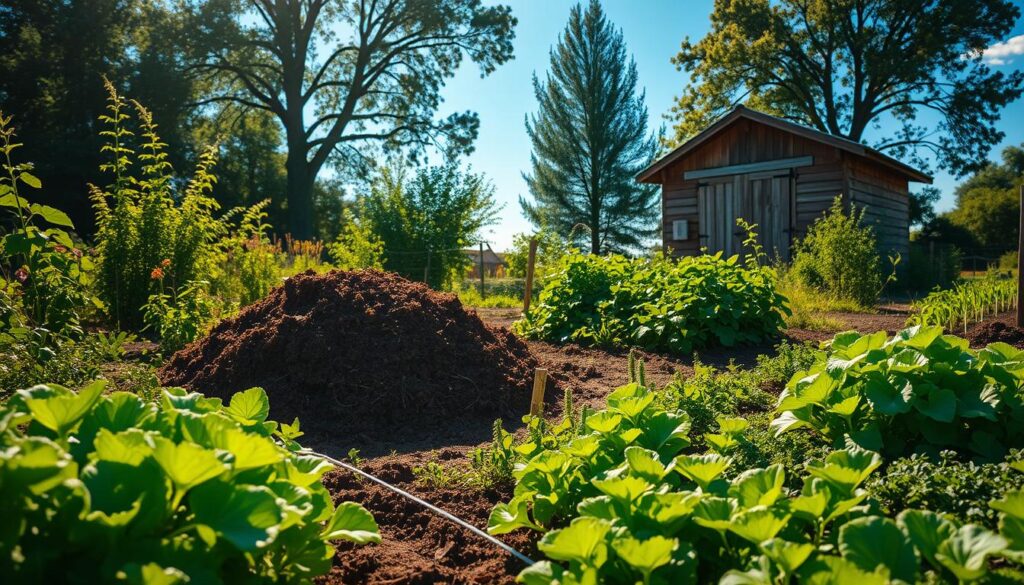
Pest Control Without Chemicals
Controlling pests without chemicals is key. Encourage good bugs like bees and ladybugs. They help pollinate and control pests.
Use physical barriers and rotate crops to stop pests. Try organic methods like neem oil and diatomaceous earth too.
Organic gardening makes a healthy garden. It gives you fresh food and helps the environment.
Raising Livestock Sustainably
Raising livestock sustainably is a rewarding part of homesteading. It needs careful planning and attention to animal welfare. This approach benefits both the animals and the health of the homestead.
Choosing the Right Animals for Your Homestead
Choosing the right livestock is key. It depends on climate, land, and the animals’ purpose. Choose breeds that fit your climate and are hardy and productive. For example, cold climates need animals that resist cold well.
Popular choices for sustainable homesteads include:
- Cattle for dairy or meat
- Chickens for eggs or meat
- Pigs for meat
- Sheep or goats for wool, milk, or meat
Humane Animal Husbandry Practices
Humane treatment of livestock is ethical and boosts animal health and productivity. Free-range systems improve animal welfare. Animals need clean water, good food, and shelter.
Key humane practices are:
- Provide spacious living conditions
- Avoid antibiotics and hormones
- Regular health checks and vet care
Integrating Livestock into Your Ecosystem
Integrating livestock into your ecosystem is about creating a good relationship between animals and land. Rotational grazing is a key practice. It moves animals to different areas to avoid overgrazing.
Rotational grazing boosts soil health and biodiversity. It also increases land capacity. This reduces the need for external feed and fertilizers, closing the nutrient loop.
| Practice | Benefits |
|---|---|
| Rotational Grazing | Improves soil health, increases biodiversity, enhances carrying capacity |
| Free-range Systems | Improves animal welfare, can enhance product quality |
The Importance of Permaculture
Permaculture design is key to creating a strong and regenerative ecosystem. It was coined by Bill Mollison and David Holmgren. This system aims to make living spaces sustainable and self-sufficient by copying nature.
By using permaculture principles, people can build homesteads that are both productive and green. The main idea is to work with nature, not against it. This way, we can create ecosystems that need little outside help.
Core Principles of Permaculture Design
Permaculture design follows a set of principles for sustainable systems. These include:
- Observe and interact with nature
- Catch and store energy
- Obtain a yield
- Apply self-regulation and accept feedback
- Use and value renewable resources and services
- Produce no waste
- Design from patterns to details
- Integrate, don’t segregate
- Use small and slow solutions
- Celebrate diversity
- Use edges and value the marginal
- Creatively use and respond to change
These principles help in designing homesteads that live in harmony with nature. By following them, we can build diverse and strong ecosystems.
Applying Permaculture to Your Homestead
Using permaculture design on your homestead is a thoughtful process. It starts with observing your land and understanding its unique features. Then, you look for ways to improve it.
One important strategy is to diversify your crops and mix plants, animals, and water systems. For example, using permaculture practices in farming can boost biodiversity and cut down on outside help.
Successful Permaculture Projects
Many case studies show how permaculture can make homesteads sustainable. For example, Zaytuna Farm in California is a top example. It shows a wide variety of crops and new ways to manage water.
| Project | Location | Key Features |
|---|---|---|
| Zaytuna Farm | California, USA | Diverse crop production, innovative water management |
| Greenbelt Movement | Kenya | Community-led reforestation, sustainable land use |
| Crystal Waters | Australia | Permaculture village, eco-tourism, sustainable living |
These examples show how permaculture can turn homesteads into thriving ecosystems. They benefit both the environment and the community.
Recycling and Waste Management
Starting my journey to a sustainable homestead, I learned waste management is key. Recycling and managing waste well helps reduce our impact on the environment. It also makes our living space healthier.
To manage waste well, we need to know the different types. Organic waste can be composted, and inorganic waste can often be recycled or reused.
Building a Composting System
Composting is a big part of managing waste on a homestead. It turns organic materials like food scraps and leaves into soil that’s full of nutrients. To start composting, pick a spot for your compost and gather organic waste.
- Decide on the best composting method for you, like a bin or pile.
- Make sure to mix “green” materials (like food scraps) with “brown” materials (like dried leaves).
- Keep the compost pile healthy by turning it often and checking its moisture.
Reducing Household Waste
Reducing household waste is also key to living sustainably. We can do this by using less single-use plastics, buying in bulk, and fixing things instead of throwing them away.
- Do a waste audit to find ways to cut down on waste.
- Try to use zero waste for things like single-use plastics.
- Choose reusable items like bags, containers, and water bottles.
Creative Upcycling Ideas
Upcycling turns old or discarded items into something new and useful. It helps reduce waste and adds creativity to your homestead. You can make furniture from pallets, use mason jars for storage, or make planters from plastic bottles.
By using these ideas every day, we can cut down our waste and help the planet. Managing waste well is a journey, and every small step is important.
Community and Networking
Learning about community and networking has been key for me in sustainable homesteading. Connecting with others who have similar goals has been invaluable. It helped me through the ups and downs of homesteading.
Creating a community around sustainable living is more than finding people with similar interests. It’s about building a support system for growth, learning, and working together. Community building is a key part of sustainable homesteading. It’s where we share knowledge, resources, and experiences.
Finding Like-Minded Homesteaders
I started by going to local workshops and events about sustainable living. This let me learn from experts and meet others on a similar path.
- Join online forums and social media groups dedicated to sustainable homesteading.
- Participate in local permaculture or gardening groups.
- Attend conferences and workshops on sustainable living.
Connecting with more people showed me how important networking is. By sharing our experiences and knowledge, we can learn from each other’s successes and challenges.
Building a Local Support Network
Having a local support network is essential for a sustainable homestead’s success. This network can help during tough times, offer advice, and share resources.
| Benefits | Actions |
|---|---|
| Shared Knowledge | Organize workshops and training sessions. |
| Resource Sharing | Create a tool-sharing program or community garden. |
| Moral Support | Host regular community meetings or potlucks. |
The saying “Alone we go fast, but together we go far” really hits home for me. It’s about the power of community in sustainable homesteading.
“The power of community is something that cannot be measured. It’s the foundation upon which we build our lives, our homesteads, and our futures.”
Collaborating on Sustainable Initiatives
Working together on sustainable projects is a natural step after building a community. Together, we can achieve more than alone.
Successful projects include community-supported agriculture (CSA) programs, cooperative buying groups, and joint renewable energy projects. These projects help our homesteads and strengthen our community bonds.
In conclusion, community and networking are key for a successful sustainable homestead. By finding like-minded people, building a support network, and working together, we can create a thriving community. This community supports our journey towards a more sustainable future.
Educational Resources for Homesteaders
Homesteading is a journey of learning. It’s important to find the right educational tools. Using various resources can boost your knowledge and skills.
Recommended Books and Online Courses
Many books and online courses offer insights and advice on homesteading. Check out “The Self-Sufficient Life and How to Live It” by John Seymour and “The Encyclopedia of Country Living” by Carla Emery. For online learning, Udemy and Coursera have courses on sustainable living and homesteading.
Joining Workshops and Local Classes
Workshops and local classes are great for learning by doing. Look for them at local colleges, community centers, or homesteading groups. They cover topics like organic gardening, animal care, and sustainable building.
- Check local event calendars for homesteading workshops
- Join local homesteading groups to network and learn about upcoming events
- Consider hosting your own workshop or class to share your knowledge
Utilizing Podcasts and Online Communities
Podcasts and online communities are great for sharing knowledge and learning. Listen to “The Homesteading Hippy” and “The Self Sufficient Life” podcasts. Online forums like Reddit’s r/homesteading community are also good for connecting with others.
By using these resources, you can keep improving your homesteading skills. This will help you have a successful and sustainable homesteading journey.
Tracking Progress and Adapting Your Homestead
Creating a sustainable homestead is a journey. Tracking progress is key to reaching my goals. By watching my progress, I can see what needs work and change my ways.
Monitoring Your Journey
Keeping a journal has been a game-changer. It helps me see what’s going right and what’s not. This way, I can tweak my plans as I go.
Evaluating Sustainability Goals
Checking in on my goals keeps me focused. I look at my energy use, water saving, and waste management. This makes sure I’m on the right path.
Refining Your Approach
Adapting to new ideas is vital for a sustainable homestead. Being open to learning and adjusting helps my homestead grow stronger and greener.
FAQ
What is sustainable homesteading, and how can I get started?
Sustainable homesteading means living in a way that’s good for the planet. Start by looking at your land and what you have. Then, set goals and use methods like organic farming and renewable energy.
How do I choose the right location for my sustainable homestead?
Look at the climate, laws, and environment of the area. Make sure your land fits your needs and follows local rules. Knowing the climate helps you choose the best practices for your homestead.
What are some effective water management strategies for a sustainable homestead?
Good water management includes harvesting rainwater and using filters. It also means using water wisely. These steps help save water and make sure you have enough for your homestead.
How can I make my homestead more energy-efficient?
Use solar panels or wind turbines to save energy. Also, design your home to use the sun’s heat. These steps cut down on energy bills and use cleaner energy.
What are the benefits of permaculture design for my homestead?
Permaculture makes your homestead sustainable and self-sufficient. It boosts biodiversity and saves water. This design creates a strong and low-maintenance homestead.
How can I manage waste effectively on my homestead?
Manage waste by composting and reducing what you throw away. Use creative ways to reuse items. These steps help your homestead be greener and more sustainable.
Why is community building important for sustainable homesteaders?
Being part of a community offers support and knowledge. It lets you share experiences and work on projects together. This helps everyone learn and grow.
What educational resources are available for homesteaders?
There are many resources like books, online courses, and workshops. These help you learn the skills for a successful homestead.
How can I track my progress and adapt my homestead practices?
Keep a journal to record your journey. Regularly check if you’re meeting your goals. This way, you can always improve and make your homestead better.
What are some key principles to follow for a successful sustainable homestead?
Follow eco-friendly practices and promote biodiversity. Also, conserve resources and live self-sufficiently. These principles help you create a thriving homestead that’s good for you and the planet.
How can I integrate livestock into my homestead ecosystem?
Choose the right animals and treat them well. Include them in your ecosystem. This boosts biodiversity and makes your homestead stronger and more resilient.

